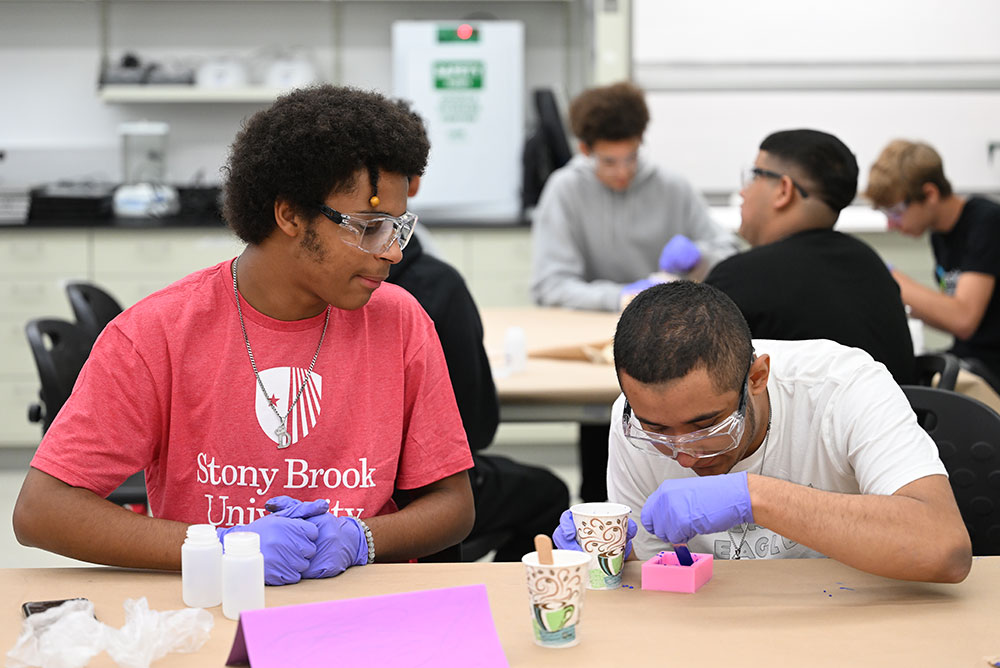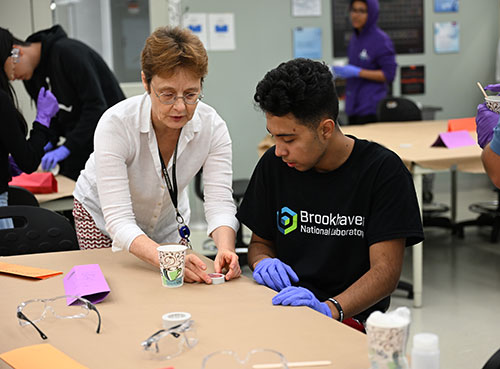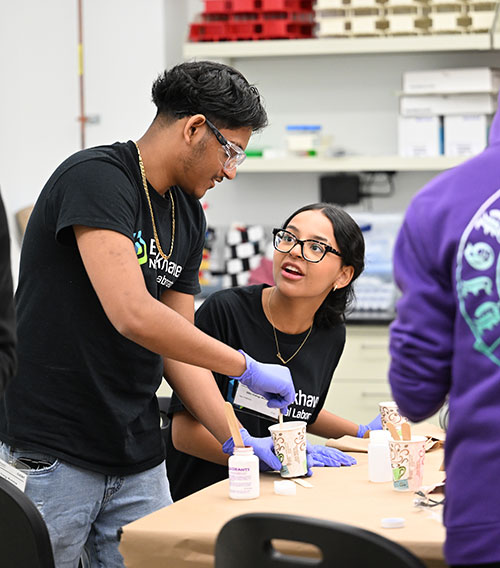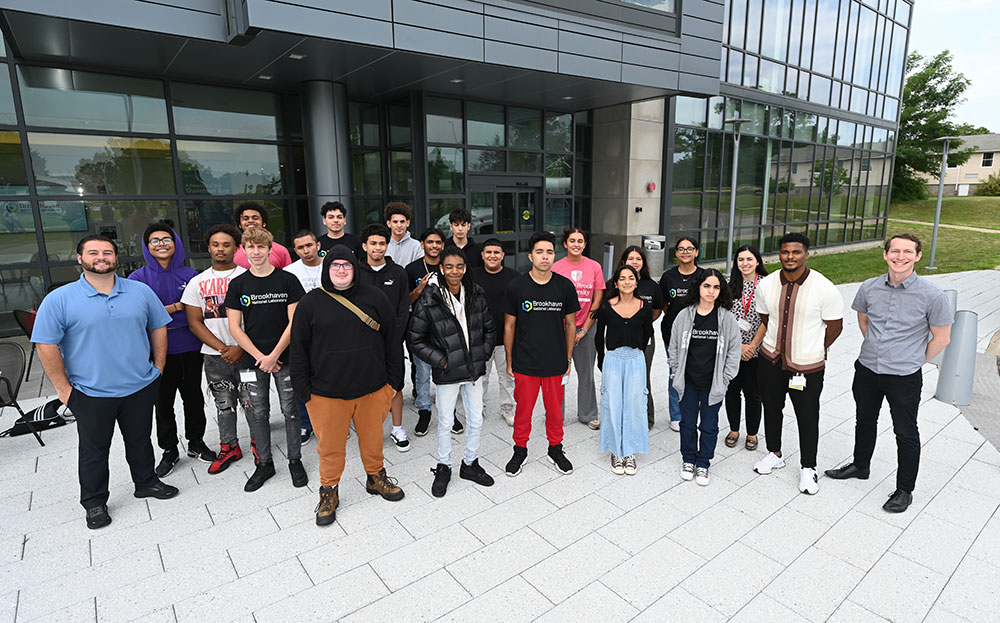Students Sample Energy Opportunities at Brookhaven Lab and Beyond
Collaboration introduces students to energy workforce pathways with sustainability and environmental justice in mind
August 8, 2024
 enlarge
enlarge
Students representing Longwood Central School District, William Floyd Union Free School District, and South Country Central School district participated in the program. (Kevin Coughlin/Brookhaven National Laboratory)
Twenty high school juniors and seniors recently spent two weeks at the U.S. Department of Energy’s (DOE) Brookhaven National Laboratory learning how scientists play key roles in developing cleaner, renewable energy sources.
The students visited the Lab through Suffolk County’s Summer Youth Employment Program for “A Taste of the Trades” for an introduction to possible pathways they can pursue in the energy workforce. Over the course of seven weeks, with additional upcoming stops at collaborating institutions Stony Brook University (SBU) and Suffolk County Community College (SCCC), the group will hear about renewable energy and advanced manufacturing for energy infrastructure projects — all while getting paid to do so. Each student receives $16 an hour through the Suffolk County Department of Labor’s Earn to Learn program.
The program, coordinated by SBU’s Office of Economic Development, kicked off on July 8 at Brookhaven Lab. Science educators arranged hands-on activities, facility tours, and overviews from scientists about their research interests in energy.
“This has been a very exciting program to collaborate on,” said Jonathan Ullmann, an educator with the Lab’s Office of Educational Programs (OEP) who helped craft the students’ syllabus. “There are many opportunities on the horizon for careers in the energy sector, but fewer avenues to introduce high school students to the entry points. At Brookhaven Lab, we are uniquely positioned to design curricula that serves as that introduction, all while highlighting the renewable energy integration and grid modernization research that we do here.”
 enlarge
enlarge
Materials scientist Tatiana Pyatina, left, showed students how to mix water-repelling cement during a demonstration on geothermal energy. (Kevin Coughlin/Brookhaven National Laboratory)
From day one, the group dove into projects that placed them in the shoes of scientists and engineers.
“The very first day we made a generator using a magnet and piece of wire,” said Nicole Alvarado, a Bellport High School student who joined the program to learn more about potential science, technology, engineering, and math (STEM) fields she could pursue. “I really liked how interactive it was. It wasn’t just lectures.”
The many activities included a lab on the effects of greenhouse gases, a workshop on how to use Python programming language to graph how much energy sunlight can provide in a given area, and a game in which students assumed the role of power generation companies bidding on electricity load forecasts for the utility grid.
Getting paid to learn was certainly an incentive to join the program, but students found value in learning from instructors who got on their level with accessible, hands-on demonstrations and in seeing major research facilities up close.
“I never really looked into electricity like this, but getting the chance to learn about it, maybe I’ll be more open to it, maybe I’ll try it in college,” said Damian Brutus of Longwood High School.
Longwood High School student Isabelle Peralta Murro said, “I’m really into engineering and STEM, and this is kind of helping me to narrow down what I want to study in the future.”
The group spent time outside of the classroom, too, with a tour of the National Synchrotron Light Source II (NSLS-II), a DOE Office of Science user facility at Brookhaven that generates ultrabright, highly stable beams of light to run its 29 experimental stations, or beamlines, that allow researchers to study the structure of materials. A handful of students noted they were impressed to learn that scientists from all over the world apply for beam time at NSLS-II, a facility near their own schools.
 enlarge
enlarge
Science educators used games and workshops to teach students about the energy grid, greenhouse gases, and more. (Kevin Coughlin/Brookhaven National Laboratory)
They also visited the Northeast Solar Energy Research Center, a solar energy research and test facility for the solar industry. Students learned how solar panels work and what makes for the best spot to build a solar farm.
Guest speakers from the Lab’s Interdisciplinary Science Department (ISD) — scientists who conduct a range of research focused on renewable and efficient energy solutions — created some of the students’ favorite moments.
Tianqiuo Zhao of the ISD’s renewable energy group gave a presentation on grid cybersecurity and Amy Marschilok, manager of ISD’s energy storage and energy systems divisions and a professor at SBU, highlighted advancements in battery research. Materials scientist Tatiana Pyatina shared an overview on geothermal energy research, along with a demo on how hydrophobic cement repels water and why that’s important in saving energy. Students had a blast mixing their own water-repelling cement slurries.
“All of the speakers we met, the mentors, and the teachers we have right now — top tier,” said Bellport High School student Jannat Majid. “Researchers gave presentations on what they were doing, and it was just really cool to see people actually using that path of research to educate.”
William Floyd High School student Raymond Ringgold, who is interested in carpentry and welding, noted the group also met college interns who are contributing to energy research.
“They all wanted to pursue internships at Brookhaven Lab and they’re just two years older than us,” Ringgold said. “That’s what stood out to me the most.”
The students’ two weeks at the Lab ended with a showcase of their own research projects designed with environmental justice goals in mind.
Divided into smaller groups, they explored how microgrids — energy sources that can connect and disconnect from the larger grid — can offer disadvantaged communities on Long Island resilience and response to climate change impacts.
They proposed placing solar panel arrays at local college campuses, hospitals, and airports in vulnerable areas to cut carbon emissions, improve energy efficiency, and provide communities with more reliable energy sources in the face of natural hazards such as coastal flooding, heat waves, and hurricanes. To support their plans, students estimated energy needs, reviewed demographic data and community vulnerability factors, weighed the pros and cons of different solar panel types, and more.
“This program is an investment in each of you,” Bernadette Uzzi, OEP’s manager for K-12 programs, told students before they presented their microgrid projects. “We hope we’ve opened your eyes to the incredible work happening at the Lab and the synergy between energy research, industry, and consumers. There are a lot of energy-related jobs on Long Island.”
 enlarge
enlarge
Students spent classroom time at the Interdisciplinary Science Building. (Kevin Coughlin/Brookhaven National Laboratory)
After Brookhaven, the group moved on to spend two weeks at SBU to learn about offshore wind, power transmission, and the energy grid. The New York State Energy Research and Development Authority will host a pre-apprenticeship at the end of week four. The students spend another two weeks at SCCC for introductions to Computer Numerical Control machining, soldering, and welding.
During the program’s seventh and final week, National Grid will lead a field trip to the Northport Power Plant, and Roman Stone Construction will facilitate infrastructure sites visit.
The program wraps with a graduation ceremony at Stony Brook’s Research & Development Park.
The Haugland Group provided students with transportation to their host sites each week. Other program supporters include Community Offshore Wind, the Workforce Development Institute, and Eversource.
Brookhaven National Laboratory is supported by the Office of Science of the U.S. Department of Energy. The Office of Science is the single largest supporter of basic research in the physical sciences in the United States and is working to address some of the most pressing challenges of our time. For more information, visit science.energy.gov.
Follow @BrookhavenLab on social media. Find us on Instagram, LinkedIn, X, and Facebook.
2024-21999 | INT/EXT | Newsroom









